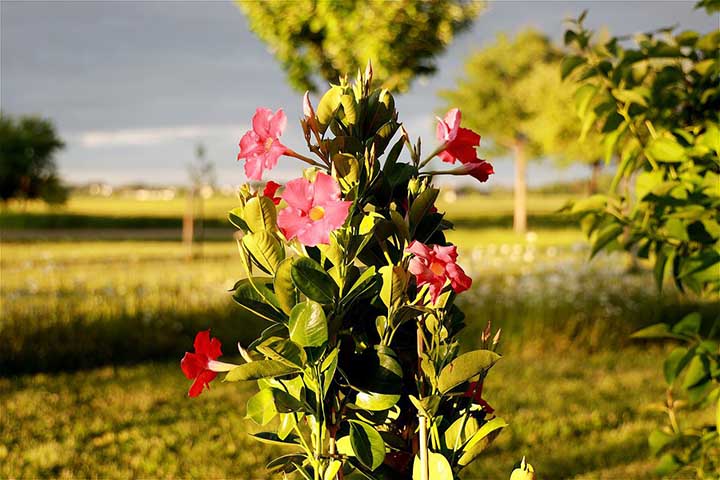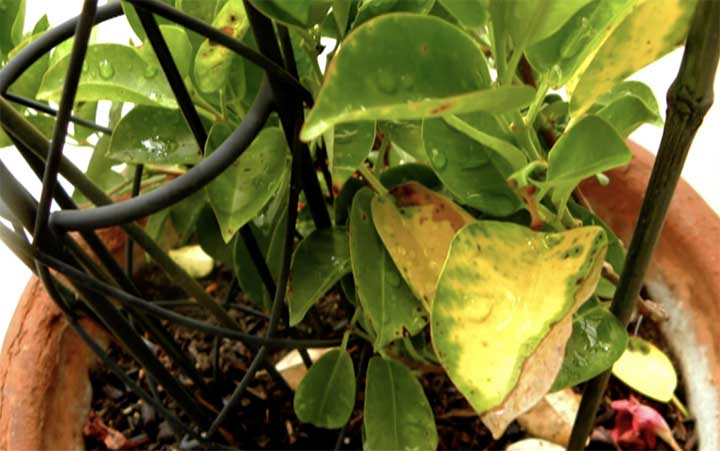Mandevilla is a beautiful vining flower of a tropical/subtropical genus, but something their leaves turn yellow.
Why are my Mandevilla leaves turning yellow?
Your Mandevilla leaves may be turning yellow for a number of natural reasons. Some of the main reasons include watering problems, light issues, not enough airflow, being planted in the wrong location, using a poor growing medium, pests, and more.
Read on below and find out why your Mandevilla leaves are turning yellow!
Table of Contents
9 Reasons ( & Solution) Why Are Mandevilla Leaves Turning Yellow
There is no one reason why your Mandevilla plants’ leaves are turning yellow. There are, however, numerous reasons.
Here are 9 of the top reasons (and solutions) why your Mandevilla leaves turn yellow:
Overwatered
One of the very top reasons Mandevilla plants’ leaves turn yellow is related to all of the various overwatering issues.
Overwatering your Mandevilla is one of the easiest mistakes you can make, especially if you use the wrong soil or containers (which we discuss further, below).
That’s why it’s so crucial to provide your plant with well-draining soil and prevent soupy soil and standing water.
Solution(s):
Make sure to use quick-draining soil and a pot that has drainage holes (or plant directly in the ground).
Following a watering schedule, and using a moisture meter to check the soil before watering, also helps a lot.
Underwatered
Mandevilla plants that are severely underwatered also turn yellow in the leaves, and eventually dry up and die altogether if they aren’t treated in time.
Whether you forget to water them, or it’s hotter than usual outside and it slips your mind to give them extra water, it doesn’t take much for these pretty vining flowers to go from thriving to diving into a rapid decline.
Severely underwatered Mandevilla generally develops both yellow and brown leaves that begin dropping.
Even more, planting Mandevilla in the wrong growing medium, somewhere too bright, or too hot, and other various factors may play into underwatering issues as well.
Solution(s):
Plant your Mandevilla in fast-draining soil, and water them thoroughly enough that the root zone never dries out completely between watering sessions.
Keeping a tight water regimen also helps tremendously. The recommended watering schedule for Mandevilla is approximately 1 to 2 inches of water every 7 to 14 days.
Too Much Light

A healthy and vibrant Mandevilla vine requires a minimum of 6 hours of direct and/or bright light each day.
Placing your plant in a garden plot that receives full sun all day may cause it to have yellow leaves constantly.
You can further identify if this is the problem if you see both yellow and brown leaves.
Likewise, placing your indoor or balcony Mandevilla plants into the direct light for a little energy boost is ok… but forgetting about them and leaving them for days is not.
Solution(s):
Plant your Mandevilla somewhere in your yard or garden that receives at least 6 hours of bright or direct light every day.
Avoid placing pots in the sun for an afternoon pick-me-up and forgetting to move them back to their normal place.
Not Enough Light
Equally devastating as too much light, not enough light may also cause your Mandevilla to turn yellow in the leaves.
Whether you’ve planted the flowers somewhere that is in the full shade, which isn’t nearly enough light, or you’ve placed their pots in the shade and forgot about them, not enough life is more than enough to turn leaves yellow after several days or weeks.
Again, Mandevilla plants require a minimum of at least 6 hours of light, but may prefer as many as 8 to 10 hours of bright light.
Solution(s):
Keep your plants in a location where they get a minimum of 6 hours of bright light per day.
If your Mandevillas don’t get 6 hours or more of direct sunlight, it is best to make sure they get 8 or 10 hours of indirect bright light instead.
Wrong Fertilizer
The wrong type of fertilization is another quick way to turn healthy green Mandevilla leaves into yellow or even yellow brown spots.
Mandevilla is a blooming tropical vine that enjoys a 20-20-20 fertilizer.
The good thing is that this particular NPK is great for a ton of other plants you may already have as well.
In other words, Mandevilla doesn’t necessarily need a fancy fertilizer, it takes the same kind of nutrients many of your ornamental plants do.
Solution(s):
Feed your Mandevilla plants a slow-release 20-20-20 fertilizer in the early spring.
Alternatively, you may feed it with a general-purpose liquid fertilizer every three weeks or so.
Not Enough Nutrients
If your soil is well-draining, your flower is planted in a great location, and if your watering it properly, there is a great chance it’s lacking nutrients if its leaves turn yellow.
You will more than likely see both yellow and brown leaves, as well as green leaves that are splotchy and/or streaked with yellow.
Solution(s):
Identify the nutrients your Mandevilla is lacking specifically and provide an organic substitute to break down over the growing season.
Or, you can take the more popular approach: apply liquid nutrients immediately when you notice the yellow leaves.
Wrong Growing Medium
The wrong growing medium is one of the main issues that sneak by under people’s noses.
You may be treating your Mandevilla for phantom issues, the whole time the soil it is growing in has been the real problem.
Mandevilla flowering vines enjoy sanding soil that drains quickly and thoroughly. In comparison to many flowering plants, it is a big change.
You wouldn’t want to plant your marigolds or tulips in the same soil.
Solution(s):
Make sure to plant or pot your Mandevilla in sandy quick-draining soil that won’t allow the roots to become overly wet. Plant your Mandevilla in a hole, or in a container, with a bit of native soil from your garden, some compost, and sand.
Wrong Climate
Mandevilla is tropical and sub-tropical plant. That means they aren’t going to grow well in all climates.
The further north you are from the equator, the less favorable the conditions become for the average Mandevilla plant.
The minimum temperatures that Mandevilla survive in are 45F to 50F degrees, which means most people need to take them inside during the winter if you expect them to live.
Greenhouses can extend the growing season for Mandevillas.
Solution(s):
Do your research before planting or investing in Mandevilla for your yard or garden.
Plant in pots if necessary so that you can take them inside for the winter.
Further, consider growing Mandevilla in a greenhouse for a longer season and more blooms.
Temperature Fluctuations
If your Mandevilla leaves are turning yellow and falling off, but you’re sure it isn’t one of the other reasons on this list, your issue is more than likely fluctuating temperatures.
If a heatwave rolls through the region or several excessively cold and frosty days occur in a row, the same result occurs: weakened Mandevillas with yellow and brown leaves falling off.
Solution(s):
Have a plan in place for protecting your Mandevilla in the case of a heatwave or early/late frosts.
Keep a few bales of hay around the plants, or place plastic bags and/or containers over them for the length of the cold weather spell.
